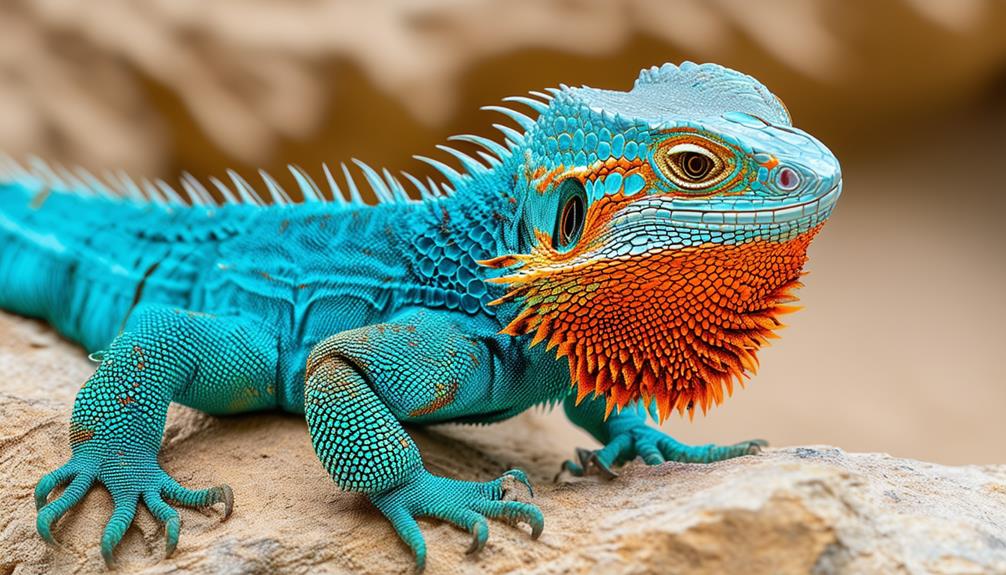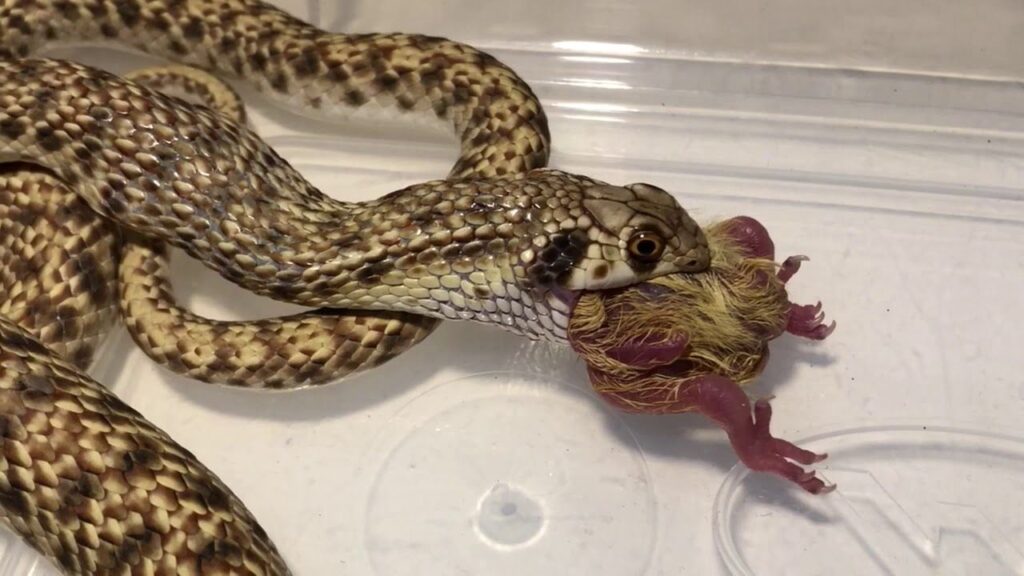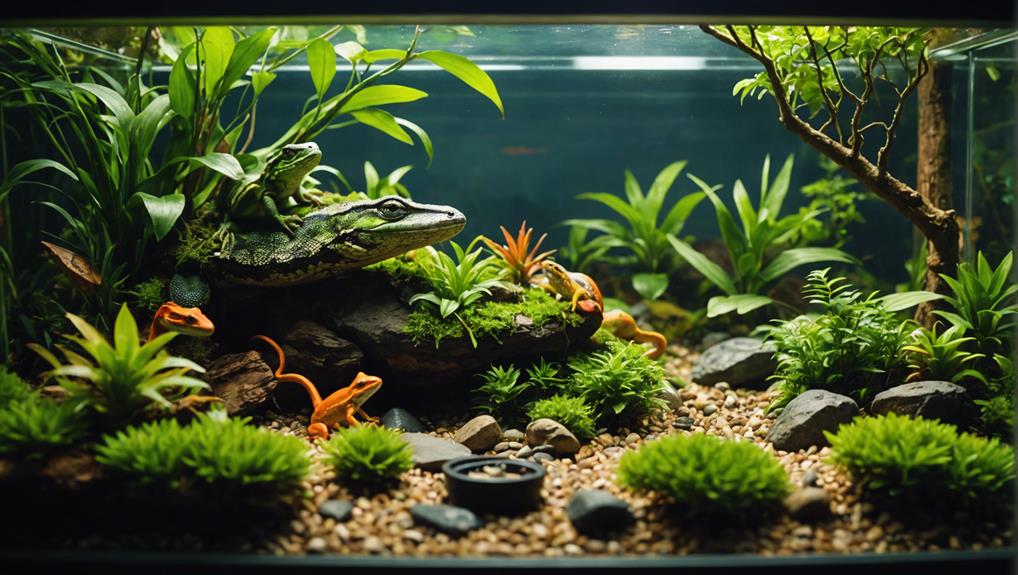You’re likely familiar with the vibrant colors of clown agamas, but did you know that these striking hues are more than just a pretty face – they’re an essential survival tool that plays a pivotal role in their daily lives.
Clown agamas change color using specialized cells called chromatophores, which contain pigments that reflect different wavelengths of light. By combining and adjusting these pigments, they can create a wide range of colors and patterns, helping them blend in with their surroundings, evade predators, and even signal their social status.
As you explore further, you’ll discover just how essential these colors are to their very existence.
Color-Changing Abilities Explained
You’re likely familiar with the astonishing ability of clown agamas to change color, a phenomenon that has fascinated herpetologists and animal enthusiasts alike.
But have you ever wondered how they manage to do it? The secret lies in specialized cells called chromatophores, which contain pigments that reflect different wavelengths of light. By expanding or contracting these cells, clown agamas can rapidly change the color of their skin to blend in with their surroundings.
There are three types of chromatophores: melanophores, which contain the pigment melanin and produce brown or black colors; iridophores, which contain plate-like crystals that reflect light and produce silver or gold colors; and xanthophores, which contain carotenoid pigments and produce yellow or orange colors.
By combining and adjusting the levels of these pigments, clown agamas can create a wide range of colors and patterns.
This unique ability is made possible by the agama’s highly developed nervous system, which allows it to rapidly respond to changes in its environment. In addition, the agama’s skin is highly flexible, allowing it to stretch and contract to accommodate the expanding and contracting chromatophores.
The result is a truly remarkable ability that has captivated scientists and animal lovers alike. By understanding the intricacies of this phenomenon, we can gain a deeper appreciation for the natural world and the incredible adaptations that have evolved in the animal kingdom.
Camouflage and Survival Strategies
As you observe a clown agama in its natural habitat, it becomes apparent that its remarkable color-changing abilities serve as a crucial tool for survival, allowing it to blend seamlessly into its surroundings and evade predators.
This impressive adaptation enables the agama to camouflage itself, making it nearly invisible to potential threats. By changing the color and texture of its skin to match its environment, the clown agama can avoid detection and reduce its chances of being attacked.
In addition to camouflage, clown agamas have developed other survival strategies to safeguard their safety.
Freezing in place: When threatened, a clown agama will often freeze in place, relying on its camouflage to remain unnoticed.
Speed and agility: Clown agamas are incredibly fast and agile, allowing them to quickly escape from predators if needed.
Social behavior: Clown agamas often live in small groups, providing an added layer of protection and vigilance against potential threats.
Mating Season Displays Unveiled
As you explore the world of Clown Agamas, you’ll discover that mating season is a time of vibrant displays.
You’ll witness the agamas’ vibrant courtship displays, flashy color signals, and ritualized dance moves that showcase their unique charm.
Now, let’s take a closer look at these fascinating displays that play a vital role in the agamas’ mating rituals.
Vibrant Courtship Displays
During the mating season, male Clown Agamas burst into vibrant courtship displays, flaunting their brightest colors to entice potential mates. You’re about to witness a spectacle that’ll leave you in awe! As you observe these magnificent creatures, you’ll notice they’re not just showing off their colors – they’re putting on a show.
Males will perform complex dance-like movements to attract females, often involving rapid head bobs, tail vibrations, and push-ups.
They’ll synchronize their color changes with their dance moves, creating a mesmerizing display of color and movement.
Males will also use vocalizations to advertise their presence and quality to potential mates, adding an auditory dimension to their displays.
As you watch these vibrant courtship displays, remember that each male is fighting for the chance to pass on his genes. It’s a high-stakes game, but one that’s essential for the survival of the species. By understanding these displays, you’ll gain a deeper appreciation for the intricate social dynamics of Clown Agamas.
Flashy Color Signals
You’re about to uncover the secrets behind the Clown Agamas’ flashy color signals, which are crucial for their mating season displays.
During this time, these remarkable creatures don their most vibrant attire, flaunting an array of colors that would put a rainbow to shame. But what’s the purpose behind this dazzling display? It’s not just about looking good – although let’s be real, they do look stunning. The flashy colors serve as a signal to potential mates, announcing an individual’s fitness, health, and genetic quality.
As you observe these agamas, you’ll notice that the males are the ones putting on the show. They’ll puff out their brightly colored throats, fan out their vibrant dorsal fins, and even perform a little wiggle dance to drive the point home.
It’s a high-stakes game, as the most impressive displays can mean the difference between attracting a mate and being left solo. So, the next time you catch a glimpse of these colorful creatures, remember that their flashy color signals are more than just a pretty face – they’re a crucial part of the Clown Agamas’ mating rituals.
Ritualized Dance Moves
Step into the vibrant world of Clown Agamas’ mating season, where ritualized dance moves take center stage, and males bust out intricate displays to woo potential partners.
As you observe these fascinating creatures, you’ll notice that their dance moves are a vital part of their mating ritual. Males will often perform complex displays to showcase their fitness and attract a mate.
Three key aspects of the Clown Agama’s ritualized dance moves are:
- Head bobs: Males will bob their heads up and down to signal their interest and availability.
- Body vibrations: They’ll vibrate their bodies to create a mesmerizing display of movement and color.
- Tail raises: By raising their tails, males can showcase their strength and agility, making them more attractive to potential partners.
As you explore further into the world of Clown Agamas, you’ll discover that these dance moves are an essential part of their mating season. By understanding these intricate displays, you’ll gain a deeper appreciation for the complex social dynamics at play in these fascinating creatures’ lives.
Social Hierarchy and Status Signaling
As you explore the social hierarchy of clown agamas, you’ll notice that dominant individuals employ specific strategies to assert their status.
These dominance display strategies, visual status cues, and rank signaling behaviors all play a vital role in establishing and maintaining their position within the group.
Dominance Display Strategies
When competing for dominance, male clown agamas resort to elaborate displays of strength, vivid coloration, and aggressive posturing to signal their status and maintain a rigid social hierarchy.
You might be wondering, what strategies do they use to assert their dominance?
To begin with, they engage in head-bobbing displays, where they rapidly bob their heads to signal aggression and strength.
They also perform push-up displays, where they do push-ups on rocks or branches to showcase their physical prowess.
Additionally, they exhibit bright coloration, where they display their vibrant colors to intimidate rivals and attract mates.
These displays are essential in establishing a pecking order among male clown agamas.
By signaling their dominance, they can secure mating opportunities, defend their territories, and maintain social status.
As you observe these fascinating creatures, remember that their elaborate displays are more than just a show – they’re a fundamental part of their social structure.
Visual Status Cues
Male clown agamas use visual status cues to convey their social status and reinforce their position within the social hierarchy. These cues are essential in maintaining social order and avoiding conflicts within their groups.
Dominant males display brighter, more vibrant colors, particularly on their heads, bodies, and tails. These striking colors signal their high social status and deter potential challengers.
Subordinate males, on the other hand, have duller colors, indicating their lower social standing.
Dominant males have larger, more prominent crests on their heads, which serve as an additional visual cue of their status.
Rank Signaling Behaviors
In the complex social hierarchy of clown agamas, males employ specific rank-signaling behaviors to advertise their status and maintain order within their groups. As you observe these fascinating creatures, you’ll notice that dominant males exhibit distinct behaviors to signal their rank. By doing so, they maintain social order and minimize conflicts within the group.
Three key rank signaling behaviors to look out for:
- Head-bobbing: Dominant males will perform a distinctive head-bobbing display to signal their dominance.
- Color changes: Males will change the color of their throat patches to signal their status, with dominant individuals displaying brighter colors.
- Vocalizations: Dominant males will produce specific vocalizations to announce their presence and maintain their rank.
Territorial Markings and Boundaries
Clown agamas establish their territorial boundaries using a combination of visual and behavioral cues to mark their territory. They use bright, vibrant colors on their bodies, particularly on their heads, throats, and bellies, which serve as a warning signal to other clown agamas, indicating that the territory is already occupied.
They also engage in specific behaviors to reinforce their territorial boundaries. They’ll often perform a series of push-ups or head-bobbing displays to signal their presence to potential intruders. These displays can be quite energetic, with the agamas rapidly moving their heads or bodies to emphasize their territorial claim.
In addition to visual cues, clown agamas also use scent markings to reinforce their territorial boundaries. They’ve scent glands on their chins, which they use to deposit pheromones on rocks, branches, and other surfaces within their territory. These scent markings serve as a chemical signal to other clown agamas, warning them to stay away.
Environmental Adaptations and Responses
As you venture further into the world of clown agamas, you’re likely to notice their remarkable ability to adapt to their environment, with specialized physical features and clever behaviors that enable them to thrive in their ecological niches.
One of the most striking examples of this adaptability is their coloration, which serves as a vital tool for survival.
For instance, clown agamas have developed a unique ability to change the color of their skin to blend in with their surroundings, making it easier for them to hunt, avoid predators, and even regulate their body temperature.
This remarkable ability is made possible by specialized cells in their skin called chromatophores, which contain pigments that can be expanded or contracted to alter the appearance of their skin.
Some key adaptations that enable clown agamas to thrive in their environment include:
- Camouflage: Clown agamas can change the color of their skin to blend in with their surroundings, making it easier for them to hunt and avoid predators.
- Thermoregulation: By changing the color of their skin, clown agamas can regulate their body temperature, helping them to conserve energy and maintain peak bodily functions.
- Communication: Clown agamas also use their color-changing abilities to communicate with other members of their species, such as during courtship or territorial displays.
Evolutionary Pressures and Selection
You’re likely to find that clown agamas have evolved to thrive in their environments due to intense selective pressures that have shaped their remarkable adaptations over time. These pressures have pushed the species to develop unique characteristics, allowing them to survive and reproduce successfully.
One of the key evolutionary pressures clown agamas face is predation. Their bright coloration serves as a warning signal to potential predators, indicating that they’re distasteful or toxic. This adaptation has evolved to protect them from predators, ensuring their survival.
| Evolutionary Pressure | Adaptation | Effect |
|---|---|---|
| Predation | Bright coloration | Warning signal to predators |
| Competition for food | Strong legs and claws | Efficient foraging and climbing |
| Environmental stress | Water conservation mechanisms | Reduced water loss in arid environments |
| Parasite and disease resistance | Immune system adaptations | Enhanced resistance to pathogens |
As you explore the world of clown agamas, you’ll realize that their remarkable adaptations are a demonstration of the power of natural selection. By understanding the selective pressures they’ve faced, you’ll gain a deeper appreciation for the intricate relationships between species and their environments.
Frequently Asked Questions
Can Clown Agamas Change Color to Express Emotions Like Happiness or Fear?
You’re curious if certain creatures can express emotions like happiness or fear through color changes. While some animals can alter their coloration, it’s not typically a direct reflection of their emotional state, but rather a response to environmental stimuli.
Do Clown Agamas Have Favorite Colors or Color Patterns in Their Habitat?
You’re curious about these fascinating creatures! As you observe clown agamas in their habitat, you won’t find them drawn to specific colors or patterns. Their focus is on finding food, shelter, and mating, not favorite hues.
Can Clown Agamas See Their Color Changes in Reflective Surfaces?
You’ll be surprised to know that 75% of animals can’t recognize themselves in mirrors! As you wonder if clown agamas can see their color changes on reflective surfaces, research suggests they might not, due to their limited self-awareness.
How Do Clown Agamas’ Color-Changing Abilities Affect Their Metabolism?
You might wonder how color-changing abilities impact metabolism. Notably, when you change color, your body temperature and energy expenditure increase, which can affect your overall metabolic rate, making you burn more energy to maintain those vibrant hues.
Can Clown Agamas Learn to Change Color by Observing Other Agamas?
As you ponder the mysterious world of reptilian learning, you wonder: can these clever creatures pick up color-changing cues from their peers? Research suggests they might, but it’s still a gray area, begging for further exploration to uncover the truth.


